Gratitude, also considered as the parent of other virtues, is a common emotion. People hold positive attitude towards it. However, does gratitude only promote prosoical behaviors? Does a dark side of gratitude exist (e.g., violating moral norms for benefitting one’s benefactor) (Figure 1)?
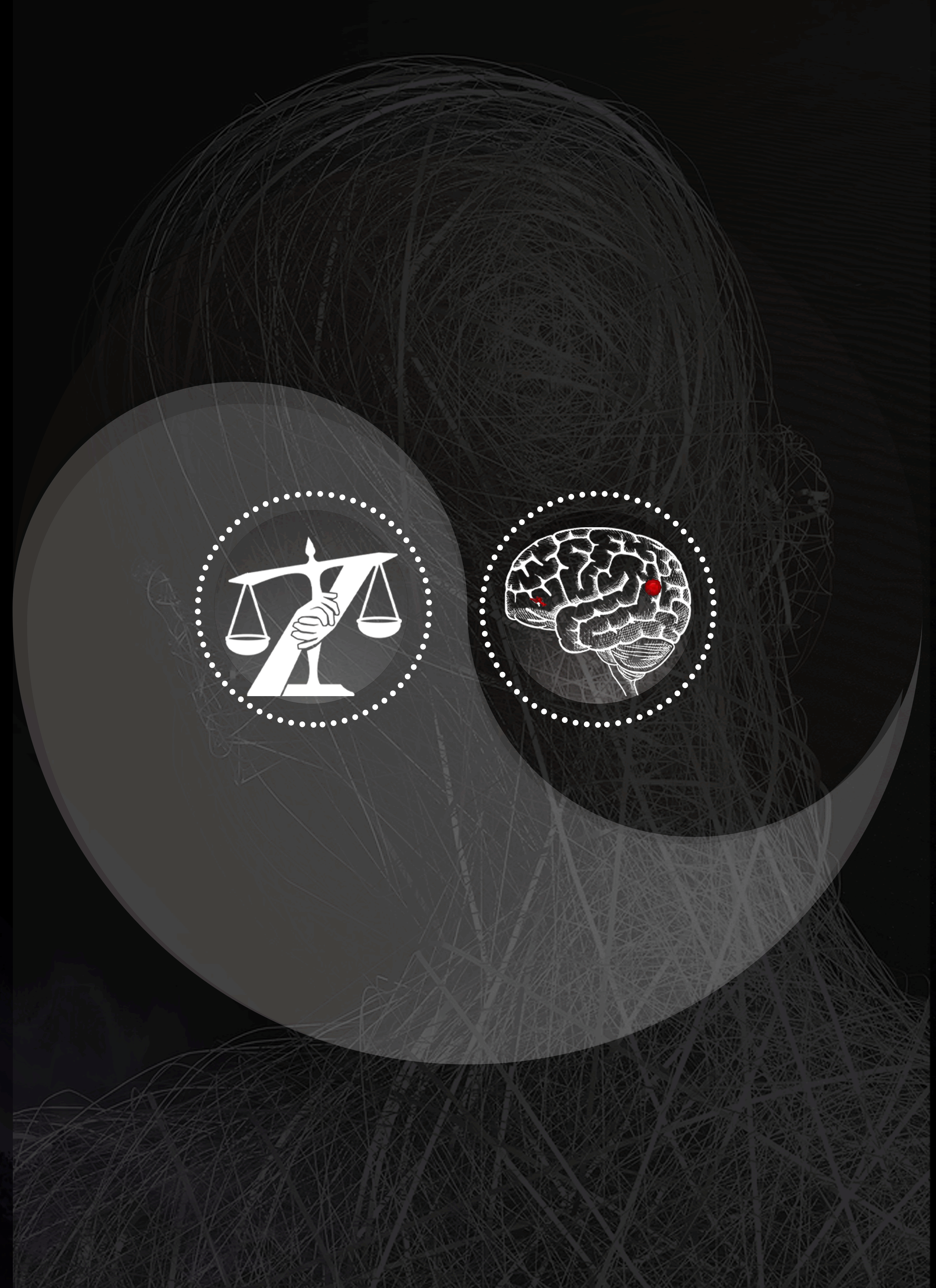
Figure 1. Gratitude could affect justice.
In November 2021, the Neuroimage published a paper entitled “From gratitude to injustice: Neurocomputational mechanisms of gratitude-induced injustice” by Dr. Chao Liu’s research group at the State Key Laboratory of Cognitive Neuroscience and Learning at Beijing Normal University. This study provides a neurocomputational mechanism of gratitude-induced injustice
Gratitude shapes individuals’ behaviors and impacts the harmony of society. Many previous studies focused on its association with prosocial behaviors. A possibility that gratitude can lead to moral violation has been overlooked until recently. Nevertheless, the neurocognitive mechanisms of gratitude-induced moral violation are still unclear.
Based on existing literature, the implement of the social function of gratitude (i.e., interpersonal relationship enhancement with high-quality partners) involves three steps. In the first step, to find a high-quality partner, individuals collect information on three relational features (i.e., cognitive antecedents of gratitude), including the intent of partners, the cost to partners for offering help, and the benefit individuals receive from the help. In the second step, the individuals integrate the collected relational information and generate gratitude accordingly, which reminds individuals that high-quality partners are identified. In the third step, gratitude guides individuals to take actions to promote a relationship in a specific situation, which eventually binds individuals and partners together in the relationship. Though previous studies have investigated the neural correlates of the first and second steps, the neural mechanisms that directly drive grateful individuals to act for relationship enhancement (i.e., the third step) are unknown.
To fill in the research gaps above, we either induced participants’ gratitude towards a partner (Gratitude group) or not (Control group) in one task and then measured participants’ punishment for their partner’s unfairness to strangers in another task with fMRI scanning (Figure 2).
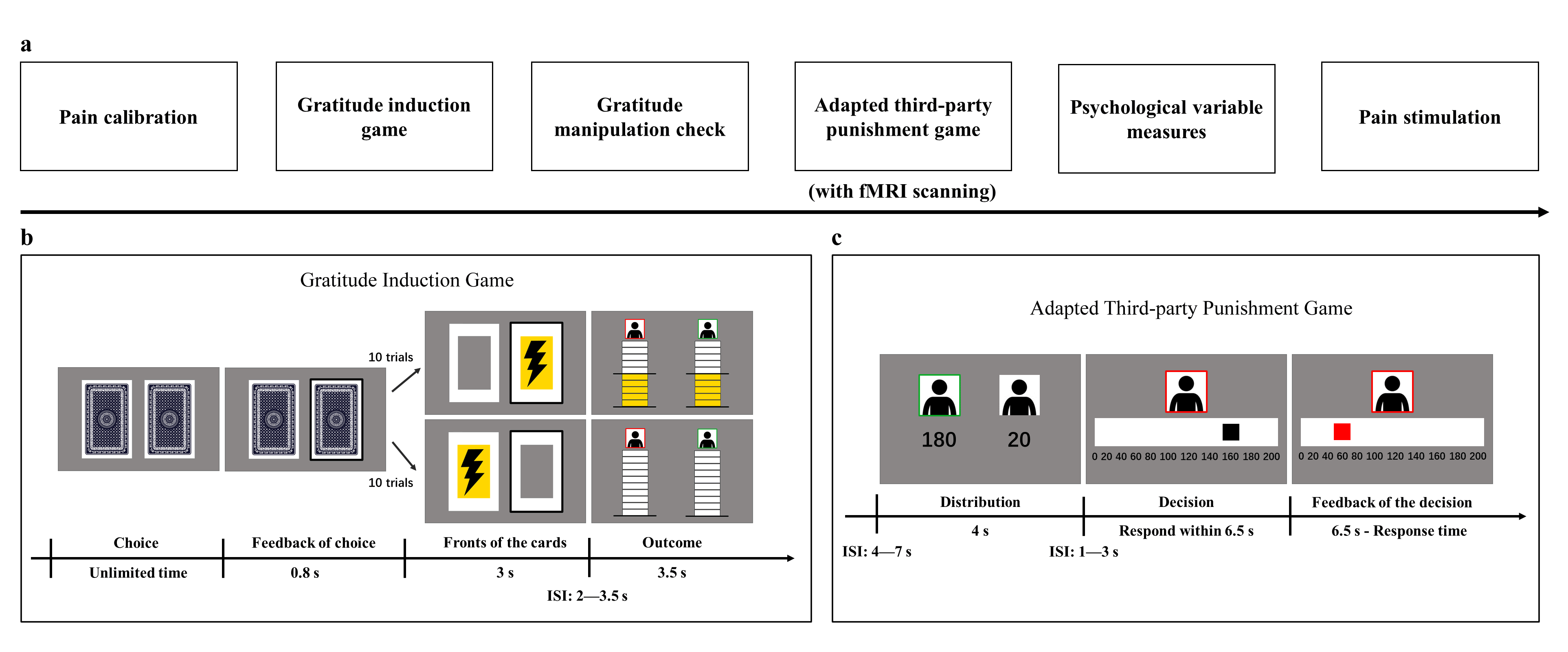
Figure 2. Experimental procedures. a, Timeline for the whole experimental session. b, Timeline for the gratitude induction game. c, Timeline for the adapted third-party punishment game.
The behavioral results show that participants in the Gratitude group deducted the partner fewer tokens than those in the Control group did (Figure 3). Both the results of self-report and computational modelling demonstrate that increased concerns for benefactors’ benefits play an important role.
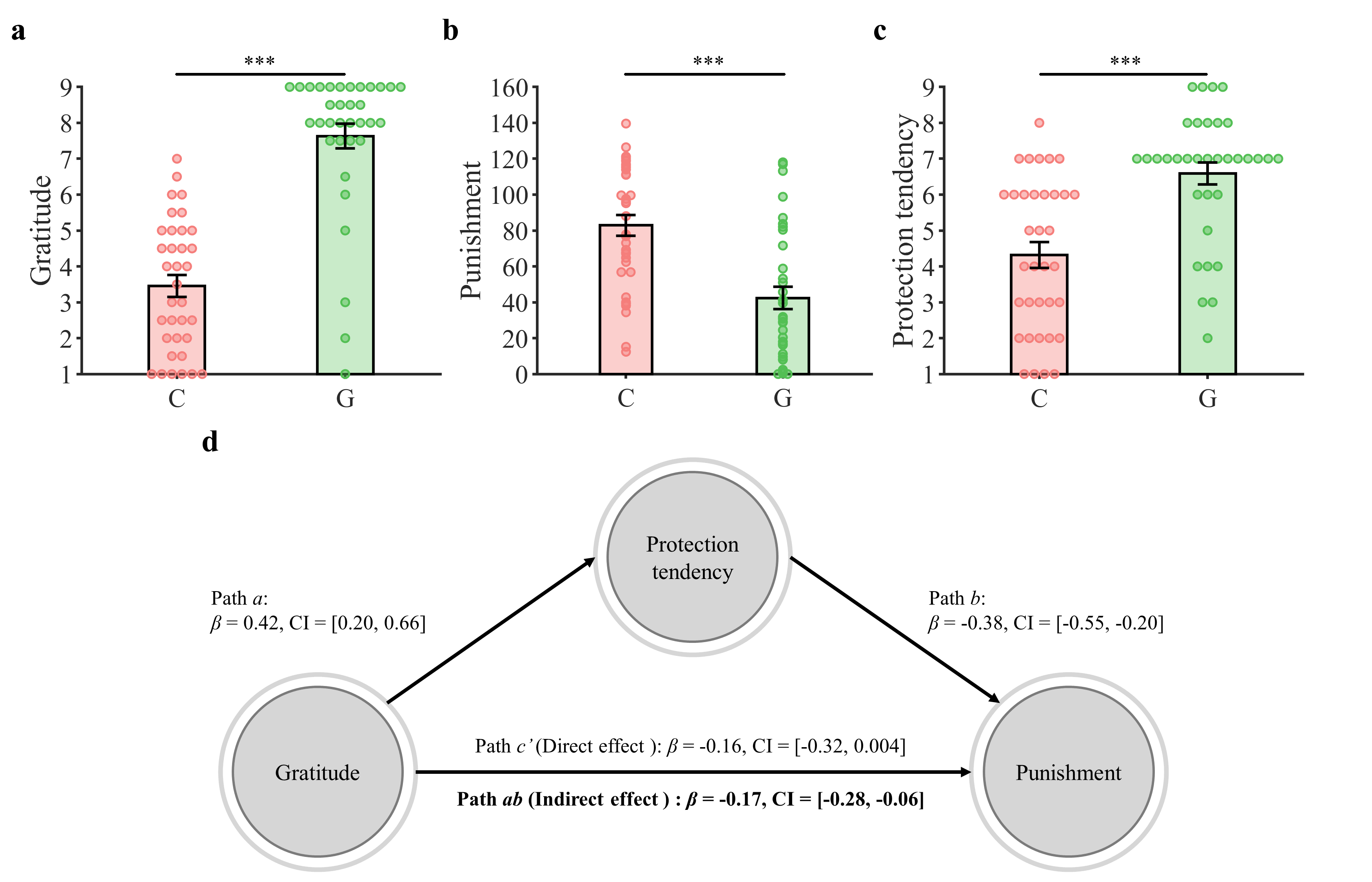
Figure 3. Behavioral results. a-c, Participants in the Gratitude group had stronger gratitude feelings (a), performed less punishment (b), and showed a stronger protection tendency (c) than participants in the Control group. C, Control group; G, Gratitude group. Data are shown as the mean ± standard error with overlaid dot plots. d, Self-reported protection tendency mediated the effect of feelings of gratitude on punishment. β, path coefficient; CI, 95% confidence interval of β; bold font, significant indirect effect.
The fMRI results reveal that brain activities associated with mentalizing (temporoparietal junction, TPJ) and reward processing (ventral medial prefrontal cortex, vmPFC) support the gratitude-induced injustice (Figures 4 and 5).
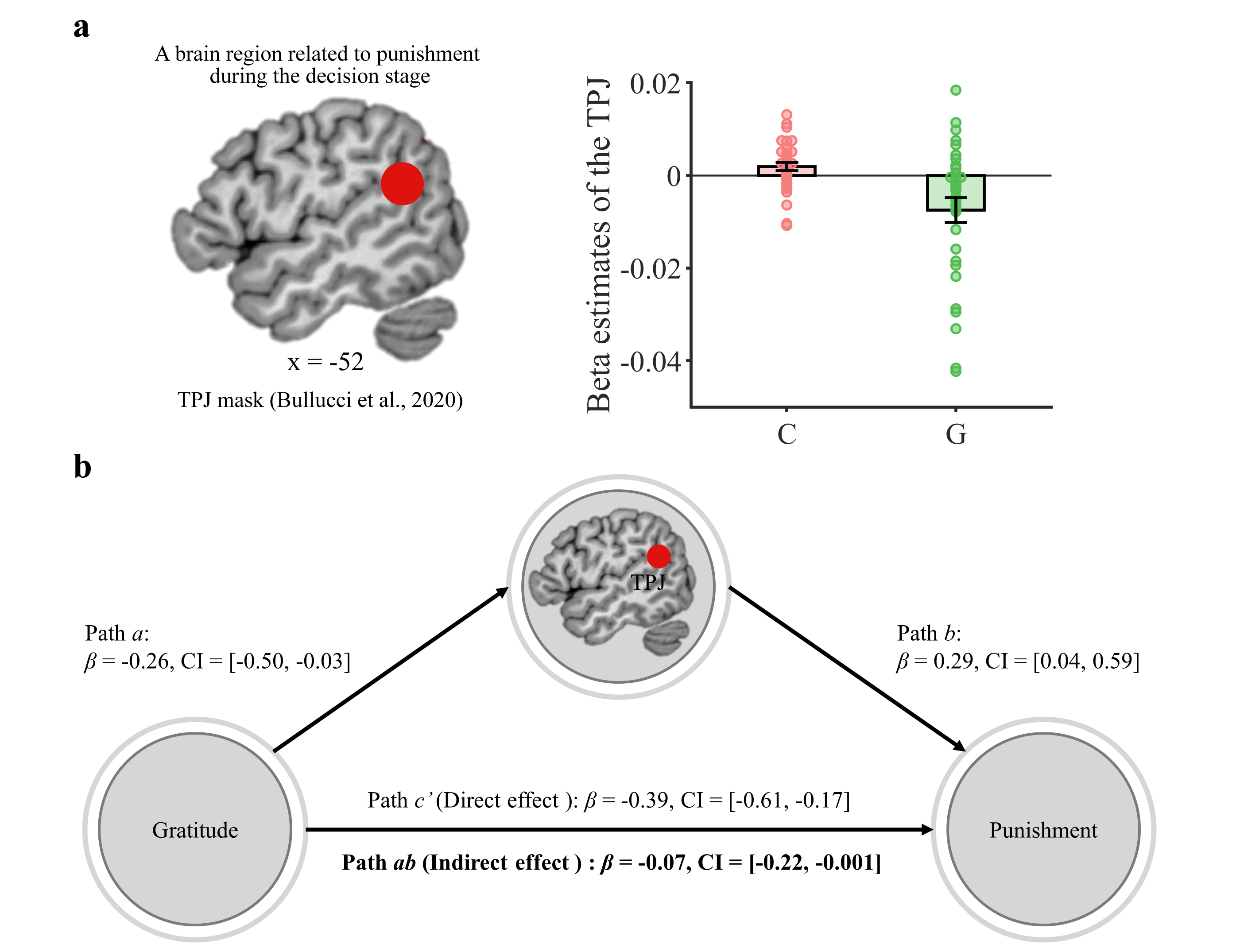
Figure 4. fMRI results of TPJ. a, During the period of making decisions, TPJ activity in the Gratitude group relative to the Control group negatively correlated with the punishment. Mean parameter estimates of the TPJ were extracted from the cluster that survived the correction. The estimates are shown as the mean ± standard error with overlaid dot plots. G, Gratitude group; C, Control group. b, Parameter estimates of the TPJ mediated the effect of feelings of gratitude on punishment. β, path coefficient; CI, 95% confidence interval of β; bold font, significant indirect effect.
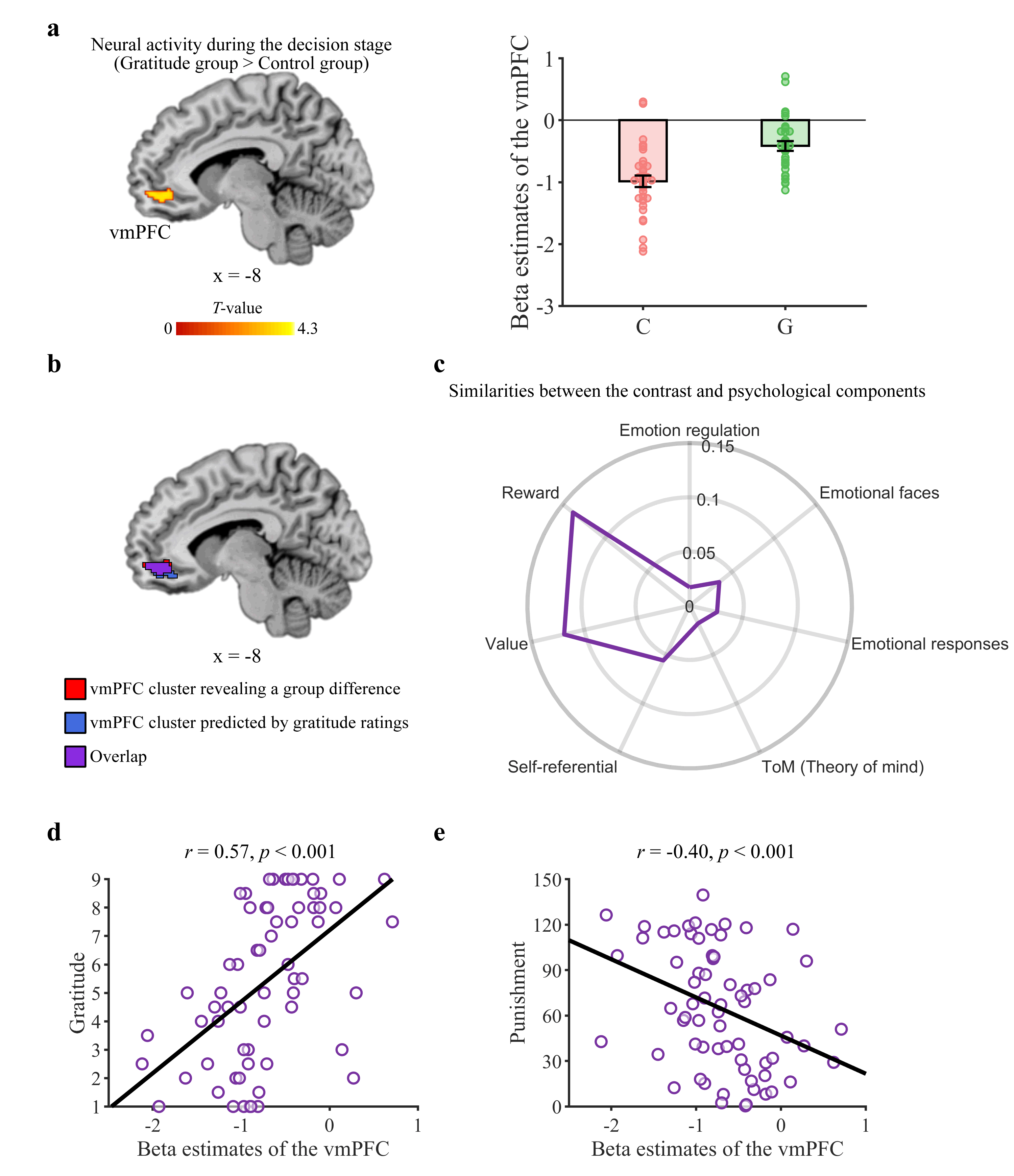
Figure 5. fMRI results of vmPFC. a, During the period of making decisions, activation of vmPFC was greater in the Gratitude than Control group. Mean parameter estimates of the vmPFC were extracted from the cluster survived the correction. The estimates are shown as the mean ± standard error with overlaid dot plots. G, Gratitude group; C, Control group. b, The vmPFC cluster in which activation was predicted by gratitude ratings overlapped with the vmPFC cluster that revealed a significant group difference in activation during the period of making decisions. c, The similarities (r values) between the T map of the Gratitude versus Control group contrast during the period of making decisions and the meta-analytical maps of terms of psychological components derived from the Neurosynth are shown. d, Parameter estimates of the vmPFC were positively correlated with gratitude. e, Parameter estimates of the vmPFC were negatively correlated with punishment.
Our findings suggest that grateful individuals concern for benefactors’ benefits, value chances to interact with benefactors, and refrain from action that perturbs relationship-building (i.e., exert less punishment on benefactors’ unfairness), which reveal a dark side of gratitude and enrich the gratitude theory (i.e., the find-bind-remind theory). We provide mechanistic and neural accounts of gratitude-induced behavior and shed light on the nature of gratitude.
The first author, Dr. Ruida Zhu, graduated from the State Key Laboratory of Cognitive Neuroscience and Learning at Beijing Normal University. The corresponding author is Prof. Chao Liu. This work was supported by the National Natural Science Foundation of China, the Major Project of National Social Science Foundation and so on.
Zhu, R., Xu, Z., Su, S., Feng, C., Luo, Y., Tang, H., Zhang, S., Wu, X., Mai, X., & Liu, C. (2021). From gratitude to injustice: Neurocomputational mechanisms of gratitude-induced injustice. NeuroImage, 245, 118730. https://doi.org/https://doi.org/10.1016/j.neuroimage.2021.118730